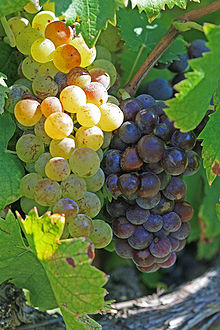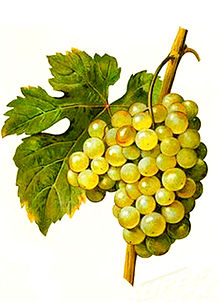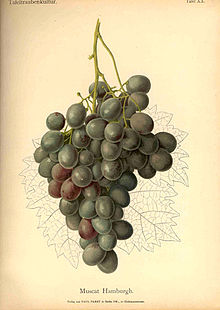Muscat (grape)
| Muscat | |
|---|---|
| Grape (Vitis) | |
 Muscat Blanc à Petits Grains and Muscat Noir showing the white and black-skinned color mutation of the variety | |
| Species | Vitis vinifera |

The Muscat family of grapes includes over 200
Among the most notable members of the Muscat family are
Muscat of Alexandria is another Muscat variety commonly used in the production of French vin doux naturel, but it is also found in Spain, where it is used to make many of the fortified Spanish Moscatels. Elsewhere it is used to make off-dry to sweet white wines, often labeled as Moscato in Australia, California and South Africa. In Alsace and parts of Central Europe, Muscat Ottonel is used to produce usually dry and highly perfumed wines.[2]
History

Theories about the origins of Muscat grapes date ancestors of the varieties back to the
The first documented mention of grapes called "muscat" was in the works of the English
Origins of the name "Muscat"

Because the exact origins of the Muscat family cannot be pinpointed, theories as to the origin of the name "Muscat" are numerous. The most commonly cited is that it is derived from the
Other theories suggest that the grape family originated in the Arabian country of Oman and was named after the city of Muscat located on the coast of the Gulf of Oman. Another city that is sometimes suggested as a potential birthplace/namesake is the Greek city of Moschato, located southwest of Athens in Attica with Moschato being a common synonym in Greece for Muscat varieties.[3]

Of the more than 200 grape varieties sharing "Muscat" (or one of its synonyms) in their name, the majority are not closely related to each other. The exception are the members of the Muscat blanc à Petits Grains and Muscat of Alexandria families. In the early 21st century,
Muscat blanc à Petits Grains and Muscat of Alexandria, themselves, have crossed and have produced at least 14 different grape varieties, 5 of which are mostly cultivated in
Muscat of Alexandria has also been crossed with the
Muscat blanc à Petits Grains has been identified as one of the parent grapes of several varieties, though with which crossing partner is currently unknown. These include the
Characteristic aromas and confusion with other grapes

Despite the vast diversity in the Muscat family, one common trait that can be seen in most all Muscat members is the characteristic floral, "
However, this common "musky" (French: musqué) trait has caused some confusion as varieties that are wholly unrelated to the Muscat family are often erroneously associated with Muscat grapes (often by naming and synonyms) due to their aromatic character. These include the
Lastly, the Muscat grape can be confused (in name only; the grapes themselves are quite different) with
Key varieties
The "Muscat family" is highly populous, with more than 200 distinct members.
Muscat blanc à Petits Grains

Muscat blanc à Petits Grains is known by many names worldwide, including Muscat Blanc (white Muscat) in
The precise origins of Muscat blanc à Petits Grains are not known, though
Nearly all the most notable sweet Muscats of Greece, particularly those from the island of Samos and the city of Patras on the Peloponnese are made from Muscat blanc à Petits Grains. In the history of South African wine, the famous dessert wine of Constantia was made from this variety of Muscat and while today Muscat of Alexandria is more widely planted in South Africa, producers around Constantia are trying to reclaim some of the region's viticultural acclaim by replanting more Muscat blanc à Petits Grains and making wines in the style of the original Constantia.[3]
Muscat of Alexandria

While the grape's name harkens to the city of Alexandria and suggest an ancient Egyptian origin, DNA analysis has shown that Muscat of Alexandria is the result of a natural crossing between Muscat blanc à Petits Grains and the Greek wine grape Axina de Tres Bias. Though as Axina de Tres Bias has also been historically grown in Sardinia and Malta, the precise location and origins of Muscat of Alexandria cannot be determined. Compared to Muscat blanc à Petits Grains, Muscat of Alexandria tends to produce large, moderately loose clusters of large oval-shaped berries that are distinctive from the much smaller, round berries of Muscat blanc à Petits Grains.[5]
Like most Muscat varieties, Muscat of Alexandria is notable for being a desirable raisin and table grape. This is due in part to the grape's high tolerance of heat and drought conditions. While it is used in wine production (most notably on the island of
In France, Muscat of Alexandria is most prominent as a blending component (with Muscat blanc à Petits Grains) in the VdN wines of
In South Africa, Muscat of Alexandria is known as "Hanepoot" and was the fourth-most widely planted white wine grape variety in the country until the early 2000s. While some of the plantings were used for wine production, particularly for fortified wine, many plantings were used for the production of
Muscat of Hamburg

Even though the vast majority of the members of the Muscat family are dark skinned grapes,
While Muscat of Hamburg is used mostly as a table grape throughout the world, there are two notable exceptions. The first is in California, where nearly all of the 102 hectares (250 acres) of Black Muscat in cultivation in 2009 were destined for wine production, primarily to produce dessert wines.
Muscat Ottonel

Like Muscat of Hamburg, Muscat Ottonel is a relatively recent addition to the Muscat family, being bred in the
While varieties such as Muscat of Alexandria tend to thrive in very warm
Other notable varieties



- Muscat of Bornova
- Canada Muscat
- Early Muscat
- Golden Muscat
- Manzoni Moscato
- Moscatello Selvatico
- Moscato di Scanzo
- Moscato di Terracina
- Moscato Giallo (Yellow Moscato)
- Moscato rosa del Trentino (Pink Moscato of Trentino)
- Muscat Bailey A
- Muscat bleu (Blue Muscat)
- Muscat d'Eisenstadt
- Muscat Fleur d'Oranger
- Muscat Odessky
- Muscat of Norway
- Muscat Oliver
- Muscat Rose à Petits Grains
- Muscat Rouge à Petits Grains
- Muscat Swenson
- Muškát moravský
- New York Muscat
- Riesling Muscat
Synonyms
This section relies largely or entirely on a single source. (May 2018) |
While each individual Muscat variety has its own set of synonyms, the general prefix of "Muscat" has its own unique translation around the globe. In Greece, the grapes are usually known as "Moschato" or "Moschoudia", while in Italy, they are known as "Moscato" or "Moscatello". On the Iberian peninsula, Portuguese and Spanish Muscat grapes are often prefixed as "Moscatel", while in Germany, the grapes are usually known as "Muskat" or "Muskateller". The family of Muscat varieties are known as "Misket" in Bulgaria and Turkey, "Muškat" in Croatia and "Muskotály" in Hungary. In the northern African wine regions of Tunisia, the grapes are often known as "Meski".[3]
See also
References
- ISBN 1-85732-999-6.
- ^ ISBN 9781905819157.
- ^ ISBN 978-1-846-14446-2.
- ^ ISBN 0-19-860990-6.
- ^ ISBN 0-15-100714-4.
